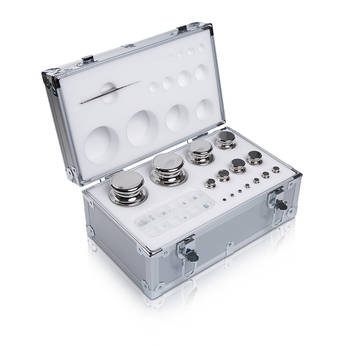1. Precision manufacturing process guarantees basic accuracy
Laboratory calibration weights are the core reference tools for calibration of various electronic balances and weighing equipment. Their manufacturing process is strictly carried out in accordance with international standards (such as E1, E2, F1, F2 and other accuracy levels). Weights are usually made of high-density, low-magnetic stainless steel materials, and are precision machined and polished to ensure a regular shape and smooth surface, thereby reducing the influence of air buoyancy and static electricity on the weighing results.
In addition, during the production process, the weights need to undergo multiple heat treatments and stabilization treatments to eliminate internal stress and prevent deformation or mass drift during long-term use, thereby providing a stable and reliable reference value for weighing.
2. Grading accuracy meets different measurement needs
Depending on different usage scenarios and accuracy requirements, laboratory weights are divided into multiple levels, ranging from the highest accuracy E1 level to the more common M1 level. High-grade weights are used for calibration of national metrology institutions or high-precision analytical balances, while lower-grade weights are suitable for routine calibration in conventional laboratories or industrial environments.
This grading system not only ensures the measurement accuracy in different application scenarios, but also helps to extend the service life of the weights and prevent high-precision weights from being contaminated or worn in non-essential environments.
3. Environmental adaptability improves stability performance
In order to maintain stable performance in various laboratory environments, the standard weights are designed with full consideration of factors such as temperature, humidity, and air pressure. For example, the selection of materials with strong corrosion resistance can effectively resist chemical erosion; sealed packaging and constant temperature storage can help avoid quality fluctuations caused by changes in temperature and humidity.
At the same time, the weights need to be placed in a constant temperature and humidity environment for a period of time before use to allow them to reach equilibrium with the surrounding environment, thereby avoiding quality errors caused by thermal expansion or moisture absorption.

4. Standardize operating procedures to ensure measurement reliability
Even if you have high-precision weights, improper operation will affect the weighing results. Therefore, the use of standard weights must follow strict procedures: including wearing gloves to prevent grease contamination, using tweezers or special clamps to take and place weights, and avoiding direct contact with the skin or exposure to the air for too long.
In addition, regular inspection and traceability are also important links in maintaining weight accuracy. Through periodic calibration by authoritative metrology institutions, possible quality deviations can be discovered and corrected in time to ensure its credibility as a "standard".
5. Widely used in scientific research and industrial fields
Laboratory standard weights are widely used in many fields such as medicine, food, chemical industry, environmental monitoring, and university scientific research. Whether in drug ingredient analysis, food safety testing, or in the research and development and debugging of precision instruments, weights play an indispensable role.
Especially in the pharmaceutical industry, the error of micro-weighing may directly affect the safety and effectiveness of drug formulations, so extremely high requirements are placed on the accuracy and stability of weights.
Laboratory Calibration Weights achieves high accuracy and long-term stability in precision weighing through precision manufacturing, scientific classification, environmental adaptation, standardized operation and regular traceability. It is not only a standard for measuring other weighing equipment, but also an important guarantee for ensuring the reliability of experimental data and compliance of product quality. With the development of science and technology, the design and application of weights in the future will continue to progress in the direction of higher accuracy, stronger stability and smarter management.

 English
English















